 Whether you’re keeping track of your current health status, starting a fitness program, or training for a fitness competition, there’s an activity or health tracker to fit your needs.
Whether you’re keeping track of your current health status, starting a fitness program, or training for a fitness competition, there’s an activity or health tracker to fit your needs.
But searching all the available options can be confusing. Depending on your fitness goals you may need a more advanced tracker that can give you more detailed information about your progress or daily monitoring, or possibly may not need all the bells and whistles and can easily track with a more simple and often less expensive design. We break it down so you can ask the right questions when you are shopping for the right tracker for your particular needs and goals.
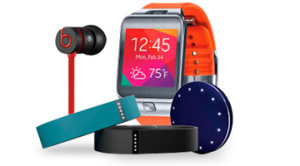 Learn about the available options to find the right tracker for your health goals.
Learn about the available options to find the right tracker for your health goals.
It’s easy to find a tracker based on your activity level. Many trackers also sync to an online app, maybe even one you already use, so it’s almost effortless to keep a log of your progress.
Basic Features – Everyday tracking
A tracker that includes some or all of the following features will help you find out your current health status as well as help you start working toward everyday activity goals:
Steps tracking
Stairs climbed
Distance traveled
Calorie counting
Sleep quality
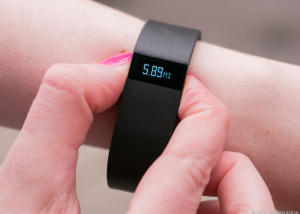 Entry-level trackers can provide a picture of your everyday habits and fitness progress to motivate you toward a goal or keep track of your current health.
Entry-level trackers can provide a picture of your everyday habits and fitness progress to motivate you toward a goal or keep track of your current health.
Steps tracking
A simple way to track your activity level is by logging the number of steps you take. The most accurate way to track your steps is with an accelerometer or GPS. With this type of tracker, you have more options of where it can be worn — from in a pocket to around your neck or on your wrist. Some activity trackers can also calculate your calories burned using this information and/or personal data.
Stairs climbed
Some activity trackers feature a built-in altimeter to record how many steps you’ve climbed each day. This is another way to monitor your activity and meet a fitness goal. Some activity trackers can also calculate your calories burned using this information and/or personal data.
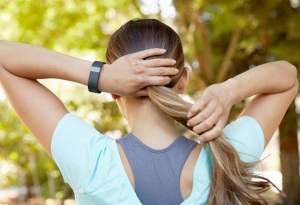 Distance traveled
Distance traveled
Keeping track of your distance traveled is another way to work toward your fitness goals for activities like running, cycling and hiking. A variety of activity trackers can calculate the distance you’ve traveled through an accelerometer or GPS.
Calorie counting
Activity trackers calculate calories burned in a variety of ways. Using your heart rate to determine this is one of the more accurate ways because it takes into account your personal exertion. Other trackers use their own equation to calculate this value — based on steps logged and/or stairs climbed. You might also input your weight and/or age to create a more custom calculation.
Sleep quality and alarm clocks
Many trackers with an accelerometer can also monitor your movement to determine sleep patterns. Some trackers require that you change to sleep mode to do this. With this information, trackers will give you a description of sleep quality based on your patterns. You can also find trackers with a silent alarm that will vibrate to wake you up.
Tracking progress online
Making it even easier to follow your progress, some trackers can download your information to a tablet, smartphone or laptop. You’ll find trackers that use Bluetooth or Wi-Fi to transfer information, whereas others download information via USB. Once the information is downloaded, apps can analyze your progress, offer personalized workout plans, compare stats with friends, and more. Apps are created for a variety of operating systems, so you’ll want to make sure the tracker’s app works with your tablet or smartphone’s operating system (such as Android, iOS, etc.). For a more comprehensive view of your habits, you may also be able to input information like what food you eat, amount of water you drink and more.
Each activity tracker comes with its own brand-specific app. Designed specifically to work with your activity tracker, this app combines all of your stats in one convenient place, making it easy to spot trends and find ways to improve your results. A variety of trackers also sync with third-party fitness apps that you may already use, such as RunKeeper, Lose It! or MapMyFitness. The easier it is to track your progress, the easier it will be to reach your health and fitness goals.
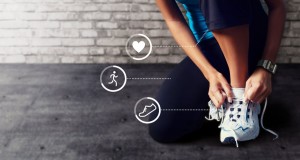 Advanced Features – Performance tracking
Advanced Features – Performance tracking
Advanced features like calorie counting and monitoring your heart rate can provide a more comprehensive picture of your lifestyle habits.
If you regularly exercise or are preparing for a competition, a tracker that includes more advanced features will help maintain motivation. Consider a tracker with some or all of the following features:
Heart rate monitor
Speed
GPS
Multi-sport tracking
Heart rate monitor
Keeping track of your heart rate is an easy way to measure your fitness exertion and stay in your target intensity zone. For activities that are not easily recorded with an accelerometer or GPS, like cycling or roller blading, you might want to consider using a heart rate monitor to track your exertion.
Heart rate monitors are available in a variety of styles. Some trackers feature sensors at the wrist that will continuously record your heart rate. A two-piece heart rate monitor will also continuously record your heart rate. This design has you wear the monitor strap around your chest, and you wear the other piece on your wrist. With this type of heart rate monitor, more advanced trackers can also count your calories burned. If you don’t want to wear a chest strap, you can see a real-time display of your heart rate with a tracker that uses a finger sensor to measure the electrical signals from your heart.
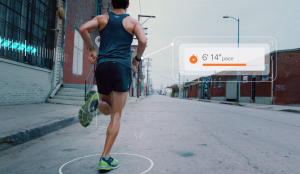 Speed
Speed
Tracking your speed is another way to work toward a fitness goal. A tracker can use an accelerometer or GPS to calculate how fast your position changes. This feature is especially helpful for a cyclist or runner who is preparing for a competition.
GPS
In addition to tracking steps and distance, a wearable device with GPS can log a variety of other information. Great for cyclists and distance runners, GPS can monitor your speed and number of laps. A GPS can also pinpoint your exact location as well as measure yardage on a golf course. Water-resistant trackers that can log strokes and distance have been created for specifically for swimmers.
A great option for someone preparing for an outdoor triathlon, keep in mind that because a tracker using GPS relies on satellite signals, it will not work indoors or can lose the signal in stormy weather or amongst tall trees and buildings.
Multisport tracking
If you’re involved in a variety of activities, such as preparing for a triathlon, no need to buy multiple trackers to suit each activity. Consider a water-resistant tracker that can gauge speed, distance and elapsed time to help you track a variety of metrics while running, cycling or swimming.
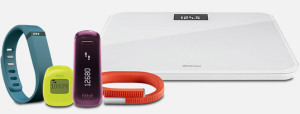 Health tracking – Scales and blood pressure monitors
Health tracking – Scales and blood pressure monitors
You can also track your health with devices that you don’t have to wear. Many of these trackers sync to online apps for an effortless log of your progress.
Scales and blood pressure monitors are another way to keep track of your everyday health. Today’s scales can do a lot more than just track your current weight, while a blood pressure monitor can keep tabs on your normal blood pressure to make sure medication is working or identify a potentially dangerous change.
Scales
Today’s scales can do a lot more than just track your current weight. You can find scales that measure your body fat, BMI, muscle mass, air quality and more. A variety of scales also wirelessly upload data via Wi-Fi and/or Bluetooth to an app that will help you track trends.
Blood pressure monitors
Taking regular blood pressure readings is a good way to monitor your heart health. Since your wrist arteries are narrower and shallower than at your forearm, you will get the most accurate reading at your arm. Some blood pressure monitors can connect to a tablet, smartphone or computer to keep a log of your readings.
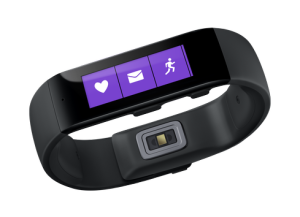 Other Features to Consider Before You Buy
Other Features to Consider Before You Buy
Style
If you prefer to be discreet about your tracking, you can find devices that are worn in your pocket, on your belt, around your neck or attached to a bra strap. There are also a variety of trackers that can be worn on your wrist. You’ll find trackers that look like traditional watches and slim styles that resemble bracelets. Pick the style you think will be easiest for you to wear every day.
Display
Trackers come with a variety of displays. Some show real-time and/or to-date progress on the tracker’s display. Others use a variety of lighted codes to let you know how you’re doing. Browse the options to find the display that will keep you motivated.
Maintaining power
Trackers feature a variety of ways to maintain power. You’ll find trackers operated by lithium-ion batteries that you can recharge via USB, coin cell batteries and cylindrical cell batteries. Each tracker features a different length of battery life. Consider which type of power fits into your lifestyle and which will be easiest for you to stay powered.
 Find the Right Activity Tracker for You
Find the Right Activity Tracker for You
Narrow down your activity tracker choices by answering a few simple questions to see which ones are best for your needs.
Activity Tracker Selector
Source: Best Buy

